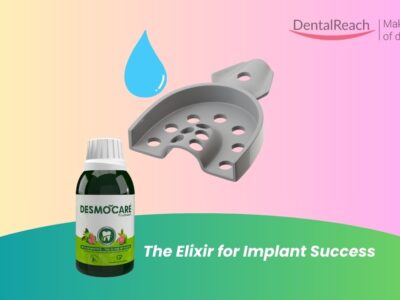Dental caries remains one of the most common and challenging diseases in modern dentistry, posing significant threats to both enamel and dentin and often leading to complex restorative procedures. Traditional dental restorative materials such as composite resin, zirconia ceramic, and other synthetic alternatives have been used to treat carious lesions, but regenerative dentistry is exploring more advanced approaches to stimulate natural dentin repair.
Among the most promising developments in this field is the use of corticosteroids, particularly in vital pulp therapy, which aims to preserve the health of dental pulp and prevent more invasive procedures like root canal therapy.
The Challenge of Deep Carious Lesions
Treating deep carious lesions presents a significant challenge due to the potential risk of pulp exposure and loss of vitality. Vital pulp therapy, which focuses on maintaining the vitality of dental pulp, is increasingly being recognized as a key strategy for long-term tooth preservation. The primary objective is to stimulate the formation of secondary or tertiary dentin to protect the pulp from further damage.
Mineral trioxide aggregate (MTA) and calcium hydroxide have long been the primary agents for vital pulp therapy, promoting secondary dentin formation. However, these materials are not without limitations, particularly in their ability to fully regenerate inflamed pulp tissues. This has prompted researchers to explore alternative approaches, including tissue-specific stem cells and the application of bioactive materials that can facilitate more effective pulp healing.
The Aspects of Tissue Engineering
Tissue engineering has recently shifted its focus towards mesenchymal stem cells (MSCs), which have demonstrated promising regenerative potential. MSCs can be sourced from various dental tissues, such as dental pulp (DPSCs), human exfoliated deciduous teeth (SHED), periodontal ligament (PDLSCs), and the apical papilla (SCAP). However, the clinical application of these cells remains limited due to challenges in obtaining sufficient numbers of stem cells and the gradual decline in their differentiation potential.
For successful tissue regeneration, not only are MSCs essential, but also a suitable scaffold that mimics the natural extracellular matrix (ECM) and promotes cell growth.
Bioactive molecules, including glucocorticoids like dexamethasone (DEX), have been studied for their role in enhancing the differentiation and proliferation of MSCs, leading to more efficient tissue regeneration and mineralization.
Dexamethasone: A Double-Edged Sword?
Dexamethasone, a potent synthetic glucocorticoid, has been widely studied for its osteoinductive properties and its role in promoting odontogenic differentiation. In vitro studies have demonstrated that DEX can enhance the remineralization of dental pulp stem cells, supporting the formation of new dentin. Its anti-inflammatory effects also make it a potential candidate for vital pulp therapy, as it helps control inflammation and promote healing.
However, the clinical use of DEX and other corticosteroids in restorative dentistry has been met with caution due to concerns about dosage and potential side effects. High concentrations of DEX can be toxic, leading to tissue necrosis and increased lipid formation. Thus, researchers are exploring ways to optimize the delivery of corticosteroids, ensuring localized and sustained release to minimize inflammation while promoting tissue regeneration.
Advances in Corticosteroid-Infused Biomaterials
Recent studies have shown that incorporating corticosteroids like DEX into synthetic scaffolds can significantly improve the outcomes of pulp therapy. Nanofibers, bioactive glass nanoparticles, chitosan nanoparticles, and hydroxyapatite microspheres are just a few examples of materials being used to deliver corticosteroids in a controlled manner. These biomaterials not only provide a structural framework for tissue regeneration but also enable the gradual release of DEX, reducing toxicity and enhancing therapeutic effects.
For instance, dexamethasone-loaded bioactive glass nanoparticles have been shown to promote the proliferation and odontogenic differentiation of dental stem cells more effectively than DEX alone. Similarly, hydrogels and hollow hydroxyapatite microspheres have demonstrated favorable results in inducing mineralization and stimulating new tissue formation.
Key Findings from Recent Research
A systematic review of recent in vitro studies has confirmed the effectiveness of topical corticosteroids, particularly dexamethasone, in promoting dental pulp remineralization. The studies included in the review found that DEX, when applied at appropriate concentrations and with suitable carriers, can enhance the expression of key osteogenic biomarkers such as alkaline phosphatase (ALP), dentin sialophosphoprotein (DSPP), and runt-related transcription factor 2 (RUNX2). These markers are critical indicators of odontoblast differentiation and the formation of mineralized tissue.
Interestingly, the review also highlighted the variability in DEX concentrations used across different studies, which could explain the inconsistent findings regarding its effects on osteogenic differentiation. While some studies reported that higher concentrations of DEX suppressed osteoblast differentiation, others found that it promoted mineralization at lower doses. This underscores the need for further research to establish optimal dosing regimens for clinical use.
Future Directions and Clinical Implications
Despite the promising results from in vitro studies, the clinical application of corticosteroids in vital pulp therapy remains in its infancy. The main challenge lies in translating these findings into effective in vivo treatments. Researchers are advocating for more standardized studies to confirm the remineralizing capabilities of corticosteroids and to determine the most effective concentrations and delivery methods.
As we move towards a future where regenerative dentistry plays a central role in clinical practice, corticosteroids like dexamethasone could become key agents in the preservation of dental pulp vitality. With further research and technological advancements, these therapies could significantly reduce the need for invasive procedures such as root canals, providing a more conservative and biologically favorable approach to dental care.
Conclusion
Corticosteroids, especially dexamethasone, offer great promise for enhancing the regenerative potential of dental pulp therapies. By promoting mineralization and supporting the differentiation of stem cells into odontoblasts, these agents could revolutionize the way deep carious lesions and exposed pulps are treated. However, more high-quality clinical trials are needed to fully understand their potential and to establish standardized protocols for their use in everyday dental practice.
As dentists, staying informed about these emerging trends in regenerative dentistry is crucial for providing the best possible care to patients and embracing the future of conservative dental treatments.
Read the whole study here: 10.1016/j.jdent.2024.105333




















Comments